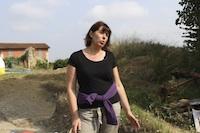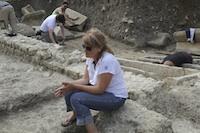Saint-Martin-de-Bruch has not yet yielded all its secrets...
This year again, and for the third consecutive year, the excavation site at Saint-Martin-de-Bruch in Lot-et-Garonne has revealed many surprises. This site, known since the 1960s, confirmed by INRAP in 2005, has only really been investigated in the last three years (excavations programmed from 2011 to 2013). It was first occupied in ancient times by a Gallo-Roman villa, reused from the 6th century to house a Merovingian necropolis, and may have been used up to the Carolingian era (10th century).
The excavations at Saint-Martin-de-Bruch are part of a research programme of the Maison des Sciences Humaines d’Aquitaine: “The Church, the Dead and the Living, from late Antiquity to the Middle Ages, funeral archaeo-anthropology and history”, led by Dominique Castex, archaeo-anthropologist (PACEA team – A3P team) and Isabelle Carton, archaeologist and Mediaevalist (AUSONIUS), a specialist on the early Middle Ages.
This programme is a good example of inter-disciplinary co-operation with LabEx, since it involves the anthropologists from PACEA and the AUSONIUS historians sharing and crossing various thematic fields: questions of funeral practices – notably studying the methods of burial and materials associated with the burials – and also questions about the construction, human occupation, use and re-use of the ancient structure.





Around forty sarcophagi, particularly well preserved, as well as walls from the ancient period, were brought to light. This year in particular, discoveries have overwhelmed the planned work, which should have finished at the end of July. They will necessitate the re-launch of negotiations to acquire land that has probably not yet yielded all its secrets. This would enable the excavations to continue and be extended, and to envisage, in the medium term, the developing and promotion of the site ready to welcome the general public.
Several tombs have in fact yielded archaeological material (everyday objects and remains of clothing) which gives more information about those buried here. These little objects raise numerous questions, notably about cultural exchanges between populations and about the social categories in the early Middle Ages. In addition, a female subject presents a cranial deformity, very probably of artificial origin, whose cause should be established. These specific cultural practices are in fact known in the Toulouse region or in Burgundy during this period.
|
|
Crâne déformé appartenant à un sujet féminin découvert sur le site, juillet 2013 |
|
Boucle de ceinture en alliage cuivreux de type aquitain (VIe-VIIe siècle) retrouvée en place sur l'un des squelettes inhumé dans un sarcophage, juillet 2013 |
The excavations at Saint-Martin-de-Bruch are part of a research programme of the Maison des Sciences Humaines d’Aquitaine: “The Church, the Dead and the Living, from late Antiquity to the Middle Ages, funeral archaeo-anthropology and history”, led by Dominique Castex, archaeo-anthropologist (PACEA team – A3P team) and Isabelle Carton, archaeologist and Mediaevalist (AUSONIUS), a specialist on the early Middle Ages.
This programme is a good example of inter-disciplinary co-operation with LabEx, since it involves the anthropologists from PACEA and the AUSONIUS historians sharing and crossing various thematic fields: questions of funeral practices – notably studying the methods of burial and materials associated with the burials – and also questions about the construction, human occupation, use and re-use of the ancient structure.
|
|
Isabelle Cartron, Ausonius |
|
Dominique Castex, PACEA |




